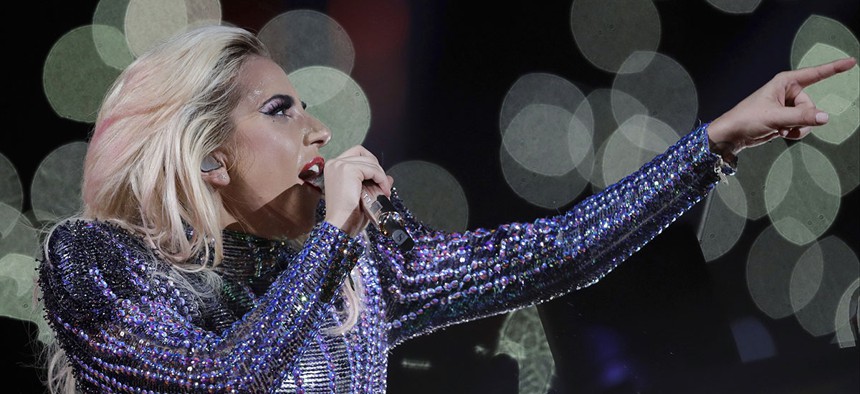Companies Want to Make Drones Less Terrifying—Before They’re Flying Everywhere

Super Bowl halftime performer Lady GaGa flew along with the drones. Darron Cummings/AP
When drones show up at the Super Bowl, it’s safe to say they’ve gone mainstream.
During last night’s Super Bowl, a bedazzled Lady Gaga sang atop the NRG stadium in Houston, Texas, as a backdrop of what seemed like stars suddenly formed the American flag. Unlike the opening to the Beijing Olympics, however, this wasn’t movie magic—a swarm of drones was flying behind Gaga, controlled by one computer, to form shapes in time with the music. At the end of her performance, the drones reappeared, this time to form the name of the company that sponsored the halftime show: Pepsi.
While many were taken with this seemingly novel use of drones (which, unfortunately, was taped before the game because of airway regulations), it’s actually just the latest in a string of stunts from Intel, the company that produced the software and drones behind Gaga’s show. The chip manufacturer recently showed off a fireworks-esque display of 500 drones in Germany and began staging nightly drone light displays at Disney World in Florida.
When drones show up at the Super Bowl, it’s safe to say they’ve gone mainstream. But why? The short answer is companies with designs on using drones for their business are getting out ahead of a complex PR battle.
Right now, the average person probably doesn’t know what drones can really do—beyond taking beautiful pictures or dropping bombs on people from a distance—but many feel a knee-jerk aversion to the devices, whether because of potential privacy or safety concerns, or more justifiable worries like potential job losses or terrorism.
As an increasing number of companies look to incorporate drones in their businesses, either to replace costly human labor or improve the services they already offer, they will be looking to overturn that negative stigma.
One of the commercials in last night’s Super Bowl, for example, was for Amazon, which teased its trial drone-delivery service in the U.K. Amazon has grand plans for offering 30-minute drone deliveries to most of its Prime subscription members, wherever they are, but there are still a few hurdles to overcome. First, the technology Amazon is currently using seems to only be feasible for people with a large yard for a drone to drop a package on, negating a large portion of Amazon’s U.S. customers.
Amazon’s dreams are also being impeded by bureaucracy: The U.S. has not figured out how to incorporate drones into the national airspace yet. The Federal Aviation Administration is currently working with NASA and a group of private-sector companies to figure out how to manage drone air traffic, but NASA is not expected to finalize its research until 2019, meaning implementation isn’t coming anytime soon.
Still, companies like Amazon can begin sowing the seeds now, by showing how useful it would be if a drone could just pop over with your delivery in a few hours, instead of a few days. And as Amazon and others test out their services in countries with looser regulations than the U.S.—a Nevada-based startup called Flirtey is currently delivering goods by drone in New Zealand—customers will be able to see the potential benefits, and possibly put pressure on lawmakers to bring drone services to the U.S.
That groundswell could come sooner than you think. Domino’s has already started delivering pizzas by drone with Flirtey; Alphabet recently partnered with Chipotle to deliver burritos to students in Virginia; UPS partnered with charities and delivery startup Zipline to start delivering medical supplies in Rwanda; Facebook wants to beam internet to every inch of the world with giant, laser-emitting drones; and even Mercedes is working with drone manufacturer Matternet on concept cars that show what the future of last-mile drone deliveries could look like.
In all of these cases, drones are either delivering goods and services faster than humans could, or delivering them to places that traditional vehicles can’t easily reach. (Or in Pepsi’s case, using drones as floating, ever-changing billboards in the sky, like some sort of "Blade Runner "dystopia become reality). Intel has told Quartz it can see its drone-swarming technology, like what Lady Gaga had buzzing behind her at the Super Bowl, being used in search-and-rescue missions, or inspecting worksites.
For now though, people are still shooting drones out of the sky, or banning them outright. While there are legitimate safety issues that drone manufacturers and regulatory bodies need to contend with—drones are still easy to crash, and people are not being educated on how to properly fly them—companies will be hoping stunts like Lady Gaga’s will help sway popular opinion toward overlooking having swarms of drones overhead at all times.





